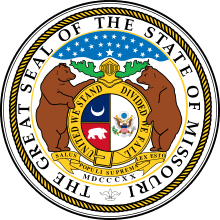Forrest Smith
| Forrest Smith | |
|---|---|
 | |
| 42nd Governor of Missouri | |
|
In office January 10, 1949 – January 12, 1953 | |
| Lieutenant | James T. Blair, Jr. |
| Preceded by | Phil M. Donnelly |
| Succeeded by | Phil M. Donnelly |
| Missouri State Auditor | |
|
In office 1933–1949 | |
| Governor |
Guy Brasfield Park Lloyd C. Stark Forrest C. Donnell Phil M. Donnelly |
| Preceded by | Lorenzo Dow Thompson |
| Succeeded by | W.H. Holmes |
| Personal details | |
| Born |
February 14, 1886 Ray County, Missouri, United States |
| Died |
March 8, 1962 (aged 76) Gulfport, Mississippi |
| Political party | Democratic Party |
| Spouse(s) | Mildred (Williams) Smith |
| Children | Two daughters: Forrestine & Mary Josephine |
| Alma mater | Westminster College (Missouri) |
| Profession | Politician |
| Religion | Methodist |
Forrest Smith (February 14, 1886 – March 8, 1962) was the 42nd Governor of Missouri. He was a Democrat.
Personal
Forrest Smith was born February 14, 1886 near Hardin in Ray County, Missouri. After receiving his secondary education at Woodson Institute in Richmond, Missouri, Smith attended Westminster College (Missouri). On October 12, 1915 he married Mildred Williams and they were the parents of two daughters, Forrestine and Mary Josephine.[1]
Career
Forrest Smith began his lifelong political career in 1910 when he became deputy assessor for Ray County, Missouri. In 1914 he was elected county clerk for Ray County, a post he held for the next eight years. From 1925 to 1932 Smith served on the Missouri state tax commission, a post that laid the groundwork for a long career in statewide elected office. In 1932 Forrest Smith was elected Missouri state auditor, a post he would hold for the next sixteen years until being elected governor in 1948.[2] According to the August 16, 1948 issue of Time magazine, Smith "helped get himself re-elected by reminding voters he was the man who mailed out the old-age pension checks."[3]
Gubernatorial Controversies: From the outset, Forrest Smith's term as governor was followed by whisper and innuendo, primarily that he owed his election to elements of organized crime.[4] By 1948 reputed Kansas City mobster Charlie Binaggio had rebuilt a powerful political machine from the ashes of the one originally created by Boss Tom Pendergast, which he used in Smiths favor. According to American Mafia.com:
"When Binaggio swung the vote for Forrest Smith and he won the Democratic nomination for governor in 1948, he convinced the gambling interests throughout the state that with their financial support Smith could win in the November election and they could “open up” the state. The amount of money the gamblers put up was estimated to be between $50,000 to $200,000, most of it from the St. Louis/East St. Louis area."
The Smith-Binaggio connection and its effect on Mob business nationwide even played a part in Senator Estes Kefauver's 1950 "Senate Special Committee to Investigate Organized Crime in Interstate Commerce", in particular the "Forrest Smith for Governor Club"[6] This mafia influence greatly tainted the relationship between Smith and the national Democratic party. Despite this, Smith, as sitting governor, was the lead delegate to the 1952 Democratic National Convention.[7] Additionally, the 1950 murder of Binaggio had closed off many avenues of fundraising and guaranteed votes. By now in his mid-60s with a lifetime of public service, Governor Smith retired from public life following completion of his term in January 1953. Governor Smith died March 8, 1962 in Gulfport, Mississippi. He is buried in Sunny Slope Cemetery, Richmond, Missouri.
Legacy
- The 1951 Municipal Land Clearance for Redevelopment Law. Signed by Governor Smith, it allowed for the issuance of bonds by cities and towns statewide, which greatly expanded and improved public infrastructure such as water and sewer, as well as new industry in blighted areas.[8]
- Forrest Lake, the centerpiece of Thousand Hills State Park near Kirksville, Missouri is named for Governor Smith.[9]
- A dormitory at the University of Missouri in Columbia, Missouri also bore his name before being torn down in 2004.
- Missouri environmentalists consider an eloquent denunciation by former Governor Smith of US Army Corps of Engineers plans to construct a dam the Current River as being one of the contributing factor to the plans' defeat.[10]
References
- ↑ http://www.nndb.com/people
- ↑ http://www.nndb.com/people
- ↑ http://www.Time.com
- ↑ http://www.Time.com April 17, 1950
- ↑ http://www.AmericanMafia.com
- ↑ Investigation of Organized Crime in Interstate Commerce by the 81st Congress, Report viewable at https://archive.org/stream/investigationofo04aunit/investigationofo04aunit_djvu.txt
- ↑ http://www.ThePoliticalGraveyard.com
- ↑ http://www.umsl.edu/~virtualstl/phase2/1950/mapandguide/millcreeknode.html
- ↑ A Book Of Adair County History, Published by Kirksville-Adair County Bicentennial Committee, 1976.
- ↑ OsarksWatch, Volume II, No. 4, Spring 1989.
| Political offices | ||
|---|---|---|
| Preceded by Phil M. Donnelly |
Governor of Missouri 1949-1953 |
Succeeded by Phil M. Donnelly |
